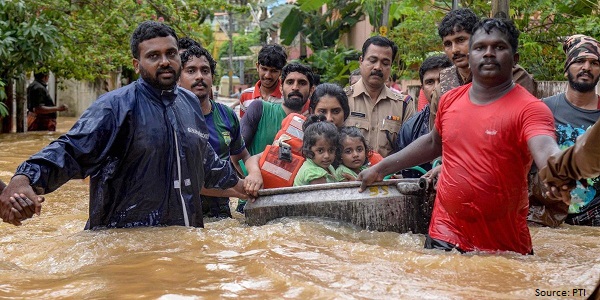
Kerala Floods: Predicted Result of Accumulated Follies
21 September 2018
This blog is part of a series on policy decisions, the causes and consquences of the Kerala floods. The first blog can be found here.
Are the changing patterns of habitations in Kerala merely a personal impression? Is the changing biodiversity and the sprawl of homes in my ancestral village, Mankurussi, a one off phenomenon? Not so; indeed they are corroborated by data contained in official reports of the state.
In 2016, as a prelude to the preparation of the state’s 13th Five Year Plan, the Kerala State Planning Board constituted a Working Group on Urban Issues. The Working Group comprised experts with rich experience on town planning, to housing, environment, energy, and participatory democracy and inclusion, and I had the privilege of co-chairing it. The opening paragraphs of the report contain insightful information on Kerala’s urbanisation, provided by a very competent Director of the Union Urban Development Ministry.
The report observes that Kerala’s settlement pattern is unique; comprising for the most part a continuous spread of habitation and increasing urbanisation. The share of urban population in total population started increasing from the 1980s (18.7% in 1981 to 26.4% in 1991) and surpassed the country’s average by 1991 (25.7%). After a slowdown during 1991-2001, the percentage of urban population in the state grew rapidly during 2001-2011 (from 25.96% in 2001 to 47.72% in 2011). Kerala is now the third most urbanised state in the country after Goa and Tamil Nadu and is reckoned by the 2011 census to be the fastest urbanising State in the country.

The report notes that Census 2011 witnessed a steep increase in the number of Census towns, over the 2001 Census. This feature is near universal; only two districts, Wayanad and Idukki have no Census towns in 2011. That is an interesting bit of information, because both Wayanad and Idukki were severely affected by the recent floods. Over 50% of the Census towns are in Kannur, Thrissur and Ernakulam districts. The number of urban agglomerations progressively rose from 9 in 1981 to 19 in 2011, of which five were newly listed in Census 2011. The 19 urban agglomerations account for 91% of Kerala’s towns and 93.74% of the urban population.
Yet, Kerala’s much lauded models of democratic decentralisation may be increasingly out of step with this rapid urbanisation. Many urban areas in Kerala, particularly the areas of continuous habitation alongside most arterial roads in the state, are still Gram Panchayats in their legal status (Table 2). This is evidenced in the difference between the number of statutory towns, namely, urban areas formally declared as urban by law and therefore served by Municipalities, and Census towns, which are still governed by Panchayats but are classified as urban areas from a Census viewpoint, based upon the population, population density and working force engaged in non-agricultural activities.

The report notes that urbanisation has not been accompanied by a formal reconfiguring of Gram Panchayats into Municipalities, or City Corporations. While on the one hand urbanised structures offer greater opportunities for economies of scale due to agglomeration, the Panchayat system offers greater opportunity for public participation as compared to the Constitutional design for urban areas. Thus, the change of status of Panchayats to Municipalities has the potential to rob citizens of platforms of participation, without replacing them with an equally potent constitutionally mandated equivalent.
The report also makes some prophetic remarks that are best reproduced in full. The report says:
“Like the rest of the world, Kerala’s cities and settlements face unprecedented threats from unsustainable consumption and production patterns, loss of biodiversity, pressure on ecosystems, pollution and increased vulnerability to natural and man-made disasters and climate change and its related risks. Kerala’s natural environment and biodiversity has been under severe stress, largely due to urbanisation. Wetlands, coastal areas, forests and hill regions have been particularly affected and these are all sensitive and delicate environments. Low density urban sprawls are devastating local micro-environments – one only has to see the high rise flats coming up next to lake shores in Kochi and the urbanisation in Munnar – as examples of such folly. Furthermore, with climate change continuing unchecked, Kerala is likely to experience more frequently, catastrophic climate related disasters. Several such have already occurred, both as intense local events or state wide ones. These will disadvantage particularly, those structures and urban sprawls that have extended into environmentally sensitive areas.”
Very prophetic words, indeed.
The next blog in the series is here.





